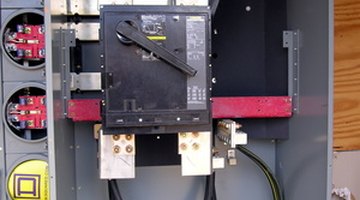How to Install an Electric Disconnect Switch
Electrical disconnect switches are required on most 240-volt appliances by electrical safety codes. The only appliances that are exempt from this are those that are within sight and within 50 feet of the breaker box.

Any appliance in another room or outside will need a disconnect switch installed nearby for the safety of any electrical service people who may have to work on the device. The disconnect switch wiring is essentially connection of a circuit breaker on the cable bringing power to the appliance.
-
Shut off the double breaker switch for the circuit that runs power to the appliance in need of an electrical disconnect switch. Put something on the breaker box to keep others from flipping the switch back on, such as a lock or a warning label.
-
Cut the cable bringing power to the appliance, if it is already wired, by slicing through the outer jacket with a utility knife. Clip each individual wire inside with wire cutters. Cut away 2 inches of the outer jacket from both freshly cut cable ends with the utility knife. Strip 1/2 inch of the insulation away from both exposed ends of the red, black and white wires with wire cutters. Strip both ends of an extra 10-inch length of white wire in the same way.
-
Remove the panel cover screws and cover plate from the electrical disconnect switch box. Push the cable end running from the house power supply into a knockout in the disconnect switch wiring panel box. Connect the black and red wires directly to the upper switch terminals marked "Line in" or "Hot." Either wire can go on either terminal. Loosen the terminal screws with a slotted screwdriver, push the bare conductors into the terminal slots and tighten the terminal screws.
-
Connect the white neutral wire from the cable to a screw terminal on the "Line neutral" block, which will be clearly labeled on a GFCI disconnect switch that bears one. Run a white wire length from another terminal on the line neutral block to the center terminal in the row of three screw terminals on the bottom of the switch. Connect the uninsulated copper ground wire to the labeled ground terminal block.
-
Push the end of the cable running to the appliance through another knockout on the box. Connect the red and black wires to the outside two screw terminals on the lower end of the switch. Either color can connect to either end. Connect the white wire to the center terminal, along with the other white wire length running from the neutral block. Connect the ground wire to a terminal on the ground block. Tighten all terminal screws firmly.
-
Cover the panel with the cover plate and tighten the holding screws to have the disconnect switch installed. Turn the power on at the home breaker panel and turn the disconnect switch on to send power to the appliance.
Things You Will Need
- Utility knife
- Wire cutters
- Slotted screwdriver
- 10-inch length 6 AWG white insulated electrical wire
Warning
Never attempt disconnect switch wiring on a 240-volt appliance unless you have been trained in residential electrical systems. Have a disconnect switch installed by a certified electrician if you do not have the necessary training and experience.
References
Writer Bio
Jonra Springs began writing in 1989. He writes fiction for children and adults and draws on experiences in education, insurance, construction, aviation mechanics and entertainment to create content for various websites. Springs studied liberal arts and computer science at the College of Charleston and Trident Technical College.
Photo Credits
- electrical panel switch image by jimcox40 from Fotolia.com
- electrical panel switch image by jimcox40 from Fotolia.com
More Articles



